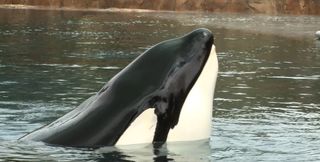Ripe Old Age: SeaWorld's Killer Whale Tilikum Near Death at 35

The killer whale named Tilikum, who made headlines after killing his trainer at SeaWorld in 2010, has a respiratory infection that may ultimately take the orca's life, at age 35. But compared with its counterparts in the wild, the aquarium showstopper has lived a long time, experts say.
Tilikum's health has declined during the past few weeks, likely because of a drug-resistant bacterial infection in his lungs, officials said.
"Tilikum's behavior has become increasingly lethargic, and the SeaWorld veterinary and animal care teams are concerned that his health is beginning to deteriorate," SeaWorld Cares said in the statement. [Orca Gallery: See Gorgeous Photos of Killer Whales]
Many people are familiar with Tilikum's storied life because of the 2013 documentary "Blackfish," which highlighted his years in captivity, including his killing of two trainers at different times. Tilikum is also associated with the death of a man who climbed into the whale's tank without SeaWorld's knowledge.
The three people who died after encounters with Tilikum were Keltie Byrne at Sealand of the Pacific in 1991, and Daniel Dukes and Dawn Brancheau at SeaWorld Orlando, in 1999 and 2010, respectively, according to CNN.
The killer whale (Orcinus orca) was captured off Iceland in 1983, and originally went to Sealand of the Pacific, an aquarium in British Columbia, before coming to SeaWorld in Orlando, Florida, in the early 1990s.
Many have called for Tilikum's release, including PETA, which posted a tweet yesterday (March 8): "Tilikum could die soon. RT if you wish he could swim in the ocean one last time."
Sign up for the Live Science daily newsletter now
Get the world’s most fascinating discoveries delivered straight to your inbox.
Though the bacterial infection may cut his life short, age 35 "is near the high end of the average life expectancy for male killer whales," SeaWorld Cares said in the statement.
This estimate is fairly on target, said Dawn Noren, a research fishery biologist at the National Oceanic and Atmospheric Administration (NOAA) Northwest Fisheries Science Center in Seattle. Noren and her colleagues keep track of the Southern Resident killer whales, which include 84 whales in three pods (nicknamed the J, K and L pods) that swim in the waters around Washington and British Columbia.
According to records, most of the males in these pods die in their 20s and 30s, Noren said. One male, J1, was estimated to be 59 years old at the time of his death in 2010. But the oldest living whale in these pods is now L41, who is 38. In fact, L41 is 9 years older than the second oldest male orca (K21) in that pod, who was born in 1986, she said.
Female killer whales in the wild tend to live longer, usually into their 40s or 50s, although some reach their 60s and 70s, Noren said. One "granny" whale, known as J2, may be around 100 years old. But it's hard to say for sure — scientists didn't begin to properly study the Southern Resident killer whales until the 1970s, and it was difficult to guess the ages of the pods' adult members at that time, Noren said.
Compared with his wild cousins, Tilikum is actually quite old for a male, she said.
"He would be considered a fairly old male in the wild population," Noren said. "He is definitely not an animal that we would be surprised would go missing out in the wild."
In the meantime, SeaWorld veterinarians are managing Tilikum's illness, according to SeaWorld Cares.
"It has been our duty and passion to make sure we give him the utmost care we possibly can," Daniel Richardville, an animal training supervisor, said in the statement.
Follow Laura Geggel on Twitter @LauraGeggel. Follow Live Science @livescience, Facebook & Google+. Original article on Live Science.

Laura is the archaeology and Life's Little Mysteries editor at Live Science. She also reports on general science, including paleontology. Her work has appeared in The New York Times, Scholastic, Popular Science and Spectrum, a site on autism research. She has won multiple awards from the Society of Professional Journalists and the Washington Newspaper Publishers Association for her reporting at a weekly newspaper near Seattle. Laura holds a bachelor's degree in English literature and psychology from Washington University in St. Louis and a master's degree in science writing from NYU.
Most Popular



